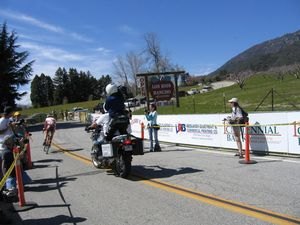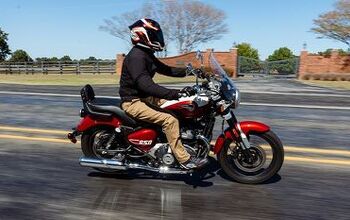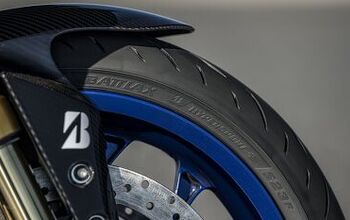The Pleasure and Perils of Escorting a Bicycle Race.
Of all the myriad things you can do with your motorcycle, one of the strangest you might ever attempt is to serve as a motorcycle escort for a bicycle race.
Particularly for a large, professional race, where the stakes are high, and the competition fierce. If you have never attempted this sort of thing before, my first piece of advice is to start small, with a couple of local, amateur events, before diving into the maelstrom of big-time, professional competition.
Over the past 30 years, I have ridden escort duty of one kind or another in over a dozen such competitions, and would like to offer the following advice and insights into this unusual motorcycling activity. Keep in mind, though, that conditions and rules vary from event to event, and often are based more on the attitude of the race promoters and organizers than on any set of written guidelines that might be provided to you.
Your Bike & Equipment
Almost any kind of motorcycle can be used for escort duty, but certain types also work better for different assignments. First and foremost, however, note that bikes with loud exhausts need not apply. If the race organizers feel that your aftermarket pipes will startle or annoy the bicyclists you are going to be riding in close proximity to, they will not allow you to participate. Nearly all stock exhausts, even the slightly louder ones found on some cruisers, are usually not a problem.
First and foremost, however, note that bikes with loud exhausts need not apply.
Obviously, the narrower your bike, the easier it is going to be to dice your way through the traffic, which is a very big part of escort duty. Big touring bikes like Gold Wings and Harley Electra Glides will work, but something like a Suzuki V-Strom is going to have a lot less trouble getting through. Personally, I prefer sport-tourers like a Honda ST, Kawasaki Concours or BMW RT.
Usually, your passenger is not going to have a motorcycle helmet. You should bring along a spare, but not a full-face. Remember, a photographer usually can't see through his viewfinder while wearing a full-face motorcycle helmet. Bring an open-face, or a modular (flip-up). Even better, if you have an intercom system (helmet-to helmet) available, either built into the bike or helmet-mounted, use it. Being able to communicate with your passenger without a lot of yelling, poking and nodding, will make your job much easier.
Picking Your Duty
In almost all cases, the race organizers are desperate for motorcycle escorts, and never have enough to cover all of the assignments. You can use this to your advantage by insisting on the type of assignment you want. In the vast majority of cases, they aren't paying you anything for your efforts, and so have no leverage available to force you to accept an assignment you are uncomfortable with. As you will see, different assignments carry different difficulty and skill levels, not to mention degrees of danger to yourself and your motorcycle.
Assignments
(In order of difficulty, from easiest to hardest)
Carrying a Marshal can actually be fun, as you will need to make high-speed runs down the sidelines, or even jump off the course and zoom through a shortcut, to catch an "offender." It's the closest most of us will ever get to participating in a high-speed police chase on city streets.
Photography - Still: For this, you will be assigned a professional still photographer as a passenger. Usually, the photographer will be from a major magazine or news service, and highly-skilled in his/her craft. Unfortunately, until you meet your "photog," you won't know if they've ever been on the back of a motorcycle before. Imagine (as once happened to me), having a 300-lb., 6-ft., 3-inch giant, with about 50 lbs. of camera gear, climb onto your back seat. Even worse, he's never been on a bike, and every time you lean into a turn, he leans the opposite way to compensate. Or, he suddenly spots a shot he wants and either stands up to get it, or twists suddenly and violently in the saddle, leaning off one side or the other. Trust me, you'll play hell just keeping your bike upright, and will be a total physical and emotional wreck by the end of the race. Of course, the opposite can happen, also. Recently, working the Redlands Classic, during the Men's Professional Heat, I was blessed with being assigned to Best bet: Look for a photographer carrying his/her own motorcycle helmet! It's a pretty sure bet they've got previous motorcycle experience. carry Sammarye Lewis. Sammarye is not only a highly-renowned bike race photographer, but rides her own motorcycle. Carrying her, even through a brutal, six-hour mountain race, was a pleasure.
Bottom line on this: If you are going to accept an assignment to carry a still photographer, you might want to check out the pool of photogs first. You will always find them clustered around the Start/Finish line, and spending a few minutes getting to know them can pay big dividends. Either check them out at an earlier race (these events always involve multiple races), or arrive early for your event, and do it then. Best bet: Look for a photographer carrying his/her own motorcycle helmet! It's a pretty sure bet they've got previous motorcycle experience.
Photography - Video: If you are assigned a video camera operator, usually from a local TV station, all of the same cautions mentioned above for a still photographer apply, but in an even greater degree. Your video guy/gal is even less likely to be motorcycle-experienced, and is carrying a much, much heavier camera. Even worse, they carry that extra weight higher, usually perched on their shoulder. Not only will your center of gravity be compromised, but there is much more probability of them banging you in the back, shoulder or back of your helmet with the lens when jockeying for a shot.
"Commissars" and Team Support...
On the plus side, the "Commissars" (officials who regulate traffic flow) and other race officials will cut you a lot more slack in moving through traffic and getting up close and personal to the racers. They know the value of TV coverage.
Team Support: Team support functions are usually only assigned to highly-experienced riders that the race organizers know and trust. Unless you've already worked a lot of races and proven your skill and your willingness to work within the rules, odds are you won't get tapped as a team support motorcycle. In fact, several of the larger professional teams bring their own motorcycles and riders along to perform this function.
A team support motorcycle carries a passenger with several assignments to perform. He will be in radio contact with his team manager, and is responsible for conveying messages to the riders on his team by writing them on an erasable tablet he carries, and having you ride in front of the racers, while he holds up the tablet for them to read. He will also watch for hand signals from his riders, and perform functions like passing them a bottle of water or a towel. As you can imagine, the racer doesn't want to slow down or lose position while getting a drink, so you need to finesse your motorcycle right up alongside him, sometimes at 40-50 mph, and hold steady enough for your passenger to hand him what he needs. All this is done in extremely heavy traffic, and is fraught with danger.
The team support bike
Remember, these are professional races, with points counting towards national and even international standings, and the sponsors literally have millions of dollars at stake.
Rules & Regulations
For one, the race will almost always have police escorts, also on motorcycles. Secondly, never, ever try to pass any of the bicycles in a curve.For one, the race will almost always have police escorts, also on motorcycles. Their job is to race ahead and block intersections, driveways and such, so no one can inadvertently stray into the path of the racers. After the racers have all passed, they then have to leapfrog back to the front again. For this, they try to keep a narrow lane clear to the left of the racers. Sometimes this is no more than a shoulder barely wide enough to get a motorcycle through, and other times it is a complete lane. Whichever it is - stay the hell out of it! I think the only reason the cops volunteer for this duty is because they can ride over 100 mph on city streets when leapfrogging to the front of the race. Heaven help you if you block their path.
Secondly, never, ever try to pass any of the bicycles in a curve. Bicyclists do a lot of passing and jockeying for position in curves. The potential for disaster is just too great. Wait for a straight section to make your move. Be patient.
Finally, never pass a bicycle or a group of bicycles unless you can give them a wide berth. Or, if it is a single bike, ease up on him until you are certain he is aware of your presence, then ease by slowly and carefully. Startling a racer is the second-greatest sin, next to actually coming in contact with him. I once saw an escort rip past a racer at about 70 mph, coming within a few inches of his shoulder. Startled, the racer swerved and ran off the course into the dirt. He regained control, but lost about three seconds. At the end of the race, he missed a second-place finish by 1.5-seconds. The team lodged an official complaint, and I don't know what happened to the escort rider, but I do know this: When I went out to the hotel parking lot the next morning, his bike was a pile of parts sitting in the parking stall where he had left it. I don't believe it was actually damaged in any way, but the team mechanics had spent the night with their portable power tools, completely disassembling it, right down to the frame.
Have Fun!
Despite all my dire warnings to the contrary, working as a motorcycle escort for a bicycle race can be a rewarding and exhilarating experience. It will test your riding skills, and give you an insider's view of bike racing you could never get anywhere else.
It's not for everyone, but I like it. You might, too.
More by Fred Rau




































Comments
Join the conversation